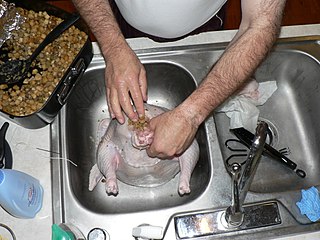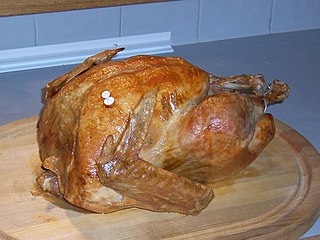
Poaching is a cooking technique that involves heating food submerged in a liquid, such as water, milk, stock or wine. Poaching is differentiated from the other "moist heat" cooking methods, such as simmering and boiling, in that it uses a relatively lower temperature. This temperature range makes it particularly suitable for delicate food, such as eggs, poultry, fish and fruit, which might easily fall apart or dry out using other cooking methods. Poaching is often considered a healthy cooking method because it does not use fat for cooking or flavoring the food.

Roasting is a cooking method that uses dry heat where hot air covers the food, cooking it evenly on all sides with temperatures of at least 150 °C (300 °F) from an open flame, oven, or other heat source. Roasting can enhance the flavor through caramelization and Maillard browning on the surface of the food. Roasting uses indirect, diffused heat, and is suitable for slower cooking of meat in a larger, whole piece. Meats and most root and bulb vegetables can be roasted. Any piece of meat, especially red meat, that has been cooked in this fashion is called a roast. Meats and vegetables prepared in this way are described as "roasted", e.g., roasted chicken or roasted squash.

Smoking is the process of flavoring, browning, cooking, or preserving food by exposing it to smoke from burning or smoldering material, most often wood. Meat, fish, and lapsang souchong tea are often smoked.

Jerky is lean trimmed meat cut into strips and dried (dehydrated) to prevent spoilage. Normally, this drying includes the addition of salt to prevent some forms of bacteria growth, and encourages others; before the meat has finished the dehydrating process. It originated in the Andes mountains in what is modern day Peru and the word "jerky" derives from the Quechua word ch'arki which means "dried, salted meat". All that is needed to produce basic "jerky" is a low-temperature drying method, and salt to inhibit bacterial growth.

Searing, or pan searing is a technique used in grilling, baking, braising, roasting, sautéing, and the like, in which the surface of the food is cooked at high temperature until a browned crust forms. Similar techniques, browning and blackening, are typically used to sear all sides of a particular piece of meat, fish, poultry, etc. before finishing it in the oven. To obtain the desired brown or black crust, the meat surface must exceed 150 °C (300 °F), so searing requires the meat surface be free of water, which boils at around 100 °C (212 °F).

Stuffing, filling, or dressing is an edible mixture, often composed of herbs and a starch such as bread, used to fill a cavity in the preparation of another food item. Many foods may be stuffed, including poultry, seafood, and vegetables. As a cooking technique stuffing helps retain moisture, while the mixture itself serves to augment and absorb flavors during its preparation.

Charcuterie is a French term for a branch of cooking devoted to prepared meat products, such as bacon, ham, sausage, terrines, galantines, ballotines, pâtés, and confit, primarily from pork.

Czech cuisine has both influenced and been influenced by the cuisines of surrounding countries and nations. Many of the cakes and pastries that are popular in Central Europe originated within the Czech lands. Contemporary Czech cuisine is more meat-based than in previous periods; the current abundance of farmable meat has enriched its presence in regional cuisine. Traditionally, meat has been reserved for once-weekly consumption, typically on weekends.

Noodle soup refers to a variety of soups with noodles and other ingredients served in a light broth. Noodle soup is a common dish across East Asia, Southeast Asia and the Himalayan states of South Asia. Various types of noodles are used, such as rice noodles, wheat noodles and egg noodles.

The following outline is provided as an overview of and topical guide to food preparation:

A meat thermometer or cooking thermometer is a thermometer used to measure the internal temperature of meat, especially roasts and steaks, and other cooked foods. The degree of "doneness" of meat or bread correlates closely with the internal temperature, so that a thermometer reading indicates when it is cooked as desired. When cooking, food should always be cooked so that the interior reaches a temperature sufficient, that in the case of meat is enough to kill pathogens that may cause foodborne illness or, in the case of bread, that is done baking; the thermometer helps to ensure this.

Pulled pork is an American barbecue dish, more specifically a dish of the Southern U.S., based on shredded barbecued pork shoulder. It is typically slow-smoked over wood ; indoor variations use a slow cooker. The meat is then shredded manually and mixed with a sauce. It may be served on bread as a sandwich, or eaten on its own.

Chicken is the most common type of poultry in the world. Owing to the relative ease and low cost of raising chickens—in comparison to mammals such as cattle or hogs—chicken meat and chicken eggs have become prevalent in numerous cuisines.
Low-temperature cooking is a cooking technique that uses temperatures in the range of about 60 to 90 °C for a prolonged time to cook food. Low-temperature cooking methods include sous vide cooking, slow cooking using a slow cooker, cooking in a normal oven which has a minimal setting of about 70 °C (158 °F), and using a combi steamer providing exact temperature control. The traditional cooking pit also cooks food at low temperature.

Turkey meat, commonly referred to as just turkey, is the meat from turkeys, typically domesticated turkeys but also wild turkeys. It is a popular poultry dish, especially in North America and the United Kingdom, where it is traditionally consumed as part of culturally significant events such as Thanksgiving and Christmas respectively, as well as in standard cuisine.

Raw meat generally refers to any type of uncooked muscle tissue of an animal used for food. In the meat production industry, the term ‘meat’ refers specifically to mammalian flesh, while the words ‘poultry’ and ‘seafood’ are used to differentiate between the tissue of birds and aquatic creatures.

A meatball is ground meat rolled into a ball, sometimes along with other ingredients, such as bread crumbs, minced onion, eggs, butter, and seasoning. Meatballs are cooked by frying, baking, steaming, or braising in sauce. There are many types of meatballs using different types of meats and spices. The term is sometimes extended to meatless versions based on vegetables or fish; the latter are also commonly known as fish balls.
















